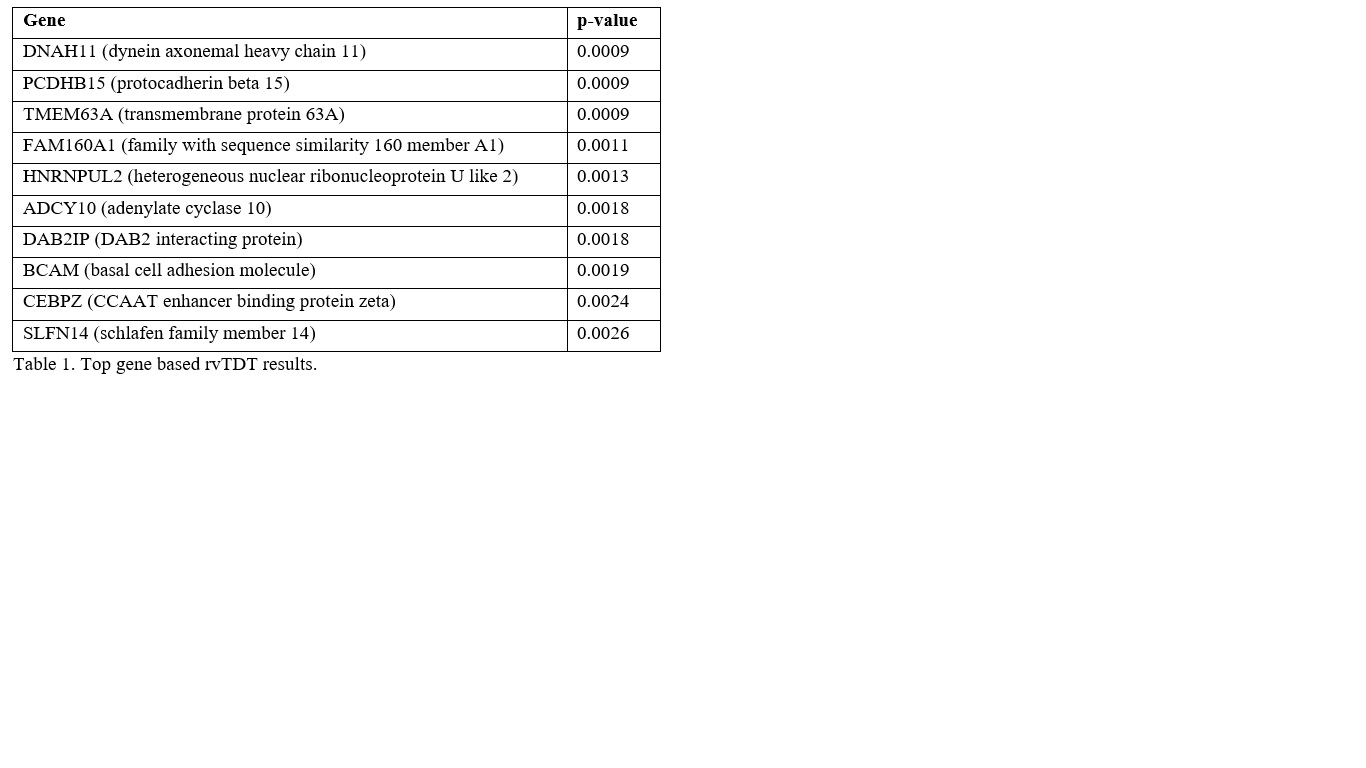Session Information
Date: Sunday, November 7, 2021
Title: Pediatric Rheumatology – Clinical Poster II: SLE, JDM, & Juvenile Scleroderma (0764–0785)
Session Type: Poster Session B
Session Time: 8:30AM-10:30AM
Background/Purpose: Systemic lupus erythematosus (SLE) is a systemic autoimmune disorder that is more severe in children than adults. Due to aggressive disease in childhood-onset SLE (cSLE), identification of genetic associations in this population could lead to insights into pathogenesis. Transmission disequilibrium test (TDT) is a family-based genetic association test performed on trios (affected patient and two unaffected parents) to compare the rate of transmission of an associated marker allele from the heterozygous parent to an affected offspring. Trio based TDT has increased power to detect association over a wide range of allele frequencies, but the empirical significance threshold has not been established for whole genome data. This is the first study to apply TDT to whole genome sequence data in a diverse, international cSLE cohort.
Methods: SLE subjects met at least 4 of 11 revised American College of Rheumatology classification SLE criteria. cSLE subjects had disease onset prior to age 18. Whole blood samples collected from 81 subjects and 111 parents underwent whole genome sequencing via Illumina HiSeq X Ten. TDT was performed to assess for association of each variant allele with cSLE in the parents with heterozygous genotypes. TDT was performed as SNP-based and gene-based analyses. SNP-based TDT was performed using PLINK 1.9. Gene-based TDT analyses used EPACTS to annotate each SNP into genes. We then employed rvTDT, which uses multiple gene-based burden tests adapted for TDT including the burden of rare variants (BRV) test. Statistical significance was determined empirically by permutation for both the SNP-based and gene-based analyses.
Results: The SNP-based analysis did not return any genome-wide significant SNPs. A SNP of interest close to the empirical significance threshold was found to be associated with the Transmembrane Protein 132C gene (TMEM132C). In the gene-based TDT analysis, many significant genes were identified (Table 1). We cross-referenced our SNP and gene-based results with results from other SLE genetic analysis. TMEM132C was also present in our gene-based analysis, although again it did not reach statistical significance. The TMEM132 family encodes for cell to cell junctions in the central nervous system. TMEM132C has not been associated with autoimmunity in prior studies, but previous genome wide association studies have found this gene to be associated with panic disorder, oncologic conditions, and hearing loss.
Conclusion: Our study identified novel genetic mutations that were statistically significant in a diverse childhood-onset lupus cohort. While no SNP reached significance across the genome, when we clustered SNPs by gene, we found many unrelated families were enriched in variants in the same gene. Future studies should be done to explore the role of TMEM132C in the pathogenesis of SLE. Our study is the first in rheumatology to apply TDT methodology to whole genome data. TDT methodology allowed for a robust analysis in a diverse patient cohort. Further studies in larger cohort of cSLE patient/parent trios will allow us to better evaluate significant SNP- and gene-based associations and identify candidate causal risk genes for SLE.
To cite this abstract in AMA style:
Vazzana K, Musolf A, Bailey-Wilson J, Deng Z, Kaplan M, Lewandowski L. Transmission Disequilibrium Testing Meets Next Generation Sequencing: Applying TDT to Whole Genome Data in Childhood-Onset Systemic Lupus Erythematosus [abstract]. Arthritis Rheumatol. 2021; 73 (suppl 9). https://acrabstracts.org/abstract/transmission-disequilibrium-testing-meets-next-generation-sequencing-applying-tdt-to-whole-genome-data-in-childhood-onset-systemic-lupus-erythematosus/. Accessed .« Back to ACR Convergence 2021
ACR Meeting Abstracts - https://acrabstracts.org/abstract/transmission-disequilibrium-testing-meets-next-generation-sequencing-applying-tdt-to-whole-genome-data-in-childhood-onset-systemic-lupus-erythematosus/

